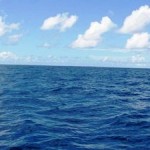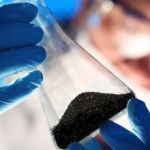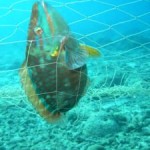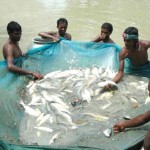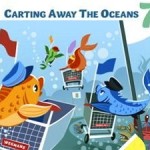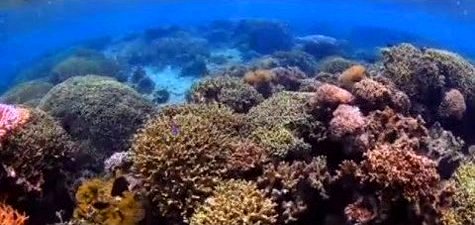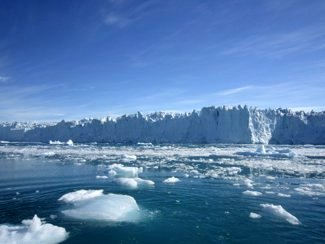 Hanover, New Hampshire – In new research published in a special issue of the journal Environmental Research and in “Sources to Seafood: Mercury Pollution in the Marine Environment” – a companion report by the Dartmouth-led Coastal and Marine Mercury Ecosystem Research Collaborative (C-MERC), scientists report that mercury released into the air and then deposited into oceans contaminates seafood commonly eaten by people in the U.S. and globally.
Hanover, New Hampshire – In new research published in a special issue of the journal Environmental Research and in “Sources to Seafood: Mercury Pollution in the Marine Environment” – a companion report by the Dartmouth-led Coastal and Marine Mercury Ecosystem Research Collaborative (C-MERC), scientists report that mercury released into the air and then deposited into oceans contaminates seafood commonly eaten by people in the U.S. and globally.
Over the past century, mercury pollution in the surface ocean has more than doubled, as a result of past and present human activities such as coal burning, mining, and other industrial processes. The research findings by C-MERC published on December 3 also examine the effects of local mercury inputs that dominate some near-shore coastal waters.
C-MERC’s research is presented through nine scientific papers in Environmental Research and is the culmination of two years of work by approximately 70 mercury and marine scientists from multiple disciplines including biology, ecotoxicology, engineering, environmental geochemistry, and epidemiology. The research provides a synthesis of the science on the sources, fate, and human exposure to mercury in marine systems by tracing the pathways and transformation of mercury to methylmercury from sources to seafood to consumers.
Two other papers focusing on the health effects of methylmercury were published earlier this year in Environmental Health Perspectives. Methylmercury has long been known as a potent neurotoxicant, particularly as a result of acute and high level human exposures primarily through seafood consumption, but more recent research has revealed health effects at increasingly lower levels of exposure.
The companion report, “Sources to Seafood: Mercury Pollution in the Marine Environment”, looks at the pathways and consequences of mercury pollution across marine systems by drawing on findings from the C-MERC papers, scientific literature, and data from a range of marine systems and coastal basins (see image below). Specifically, the report examines mercury sources, pathways, and inputs for the Hudson River Estuary, San Francisco Bay, Gulf of Mexico, Long Island Sound, Chesapeake Bay, Gulf of Maine, Arctic Ocean, and the open ocean.

C-MERC’s research findings are especially timely, as the U.S. and other nations prepare for the fifth session of the United Nations Environment Programme’s Intergovernmental Negotiating Committee (INC5) on January 13-18, 2013, in Geneva, Switzerland, which is working to prepare a legally binding instrument to control mercury releases to the environment.
“Despite the fact that most people’s mercury exposure is through the consumption of marine fish, this is the first time that scientists have worked together to synthesize what is known about how mercury moves from its various sources to different areas of the ocean and then up the food chain to the seafood most people eat,” said Celia Y. Chen, Ph.D., Research Professor of Biological Sciences at Dartmouth.
She is a co-author of the new Environmental Research papers on nutrient supply and mercury dynamics, and mercury sources in the Gulf of Maine, and authored an editorial on the subject in the journal, and is also a lead author of “Sources to Seafood”. Chen will represent Dartmouth as an accredited non-governmental organization at INC5 in an observer status. Copies of C-MERC’s “Sources to Seafood” report will be made available to INC5 attendees.
C-MERC research suggests that mercury deposited from the atmosphere ranges from 56% of the mercury loading to several large gulfs to approximately 90% in the open ocean.
“Oceans are home to large tuna and swordfish, which together account for more than half of the mercury intake from seafood for the overall U.S. population,” said Elsie M. Sunderland, Assistant Professor of Aquatic Science at Harvard University. She is a lead author of an Environmental Research paper on mercury sources in the Gulf of Maine and a lead author of “Sources to Seafood”.
Model estimates from the report indicate that methylmercury concentrations in marine fish will decline roughly in proportion to decreases in mercury inputs, though the timing of the response will vary.
“Our model estimates show that for the North Atlantic Ocean, a 20% cut in the amount of mercury deposited to the ocean from the atmosphere would lead to about a 16% decline in mercury levels in fish… But it is important to realize that achieving a 20% decrease in mercury deposition will require substantial cuts in current anthropogenic emissions, given the already very sizeable build-up of mercury in terrestrial environments and ocean waters,” said Robert P. Mason, Ph.D., Professor of Marine Sciences at the University of Connecticut. Mason is a lead author of the Environmental Research paper on mercury biogeochemical cycling in the ocean and a lead author of “Sources to Seafood”.
The C-MERC team also evaluated the fate of mercury in nearshore coastal waters and found a contrasting pattern to the oceans. “For some nearshore coastal waterbodies, like San Francisco Bay and the Hudson River Estuary, where there are large mercury sources such as historically contaminated sites, ongoing releases from wastewater or industrial waste and atmospheric mercury deposition in the watershed, mercury loading can be dominated by river inputs,” said Charles T. Driscoll, Ph.D., University Professor of Environmental Systems Engineering at Syracuse University. He is a lead author on an Environmental Research paper on nutrient supply and mercury dynamics, and a lead author of “Sources to Seafood”.

